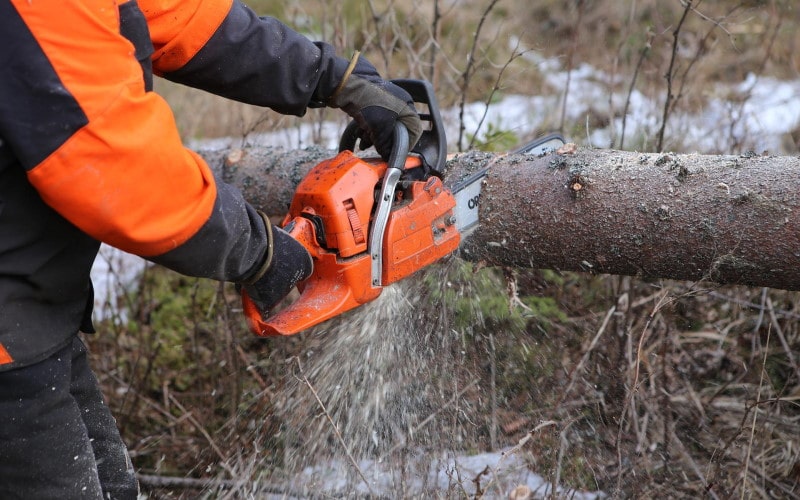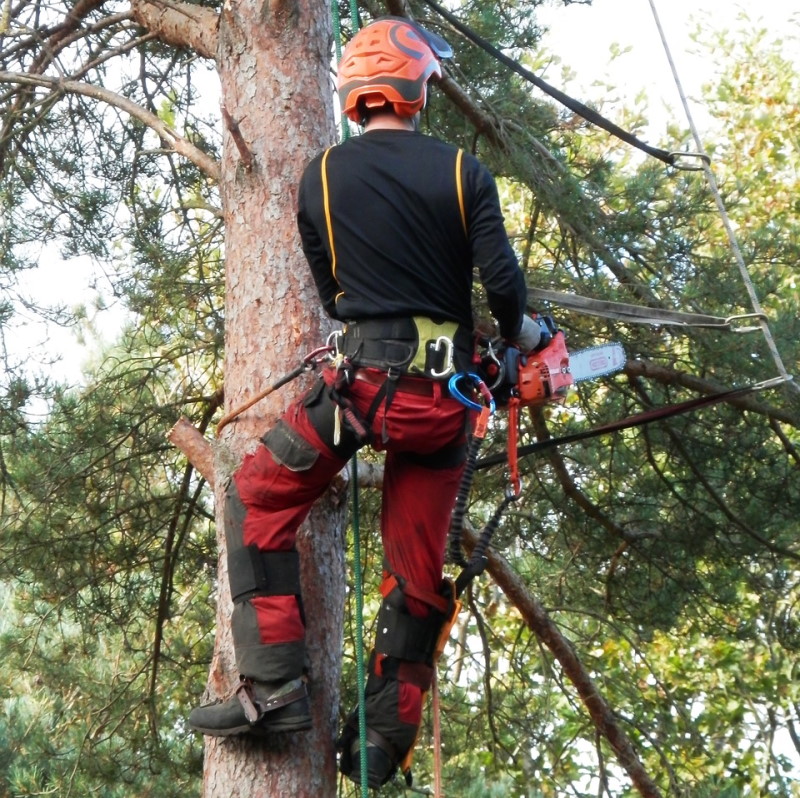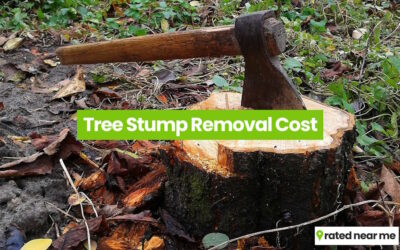How much do Tree Surgeons charge in the UK? – Keep reading to find out how to get cheaper tree surgeon quotes.
Our in-depth guide includes tree removal costs in the UK, the regulations you should be aware of before tree felling, and tips for hiring a tree surgeon.
Healthy trees can provide a welcome source of greenery for your garden, driveway or street. However, in certain circumstances, trees can also pose a serious safety risk to both property and people – especially if they become damaged or diseased.
If you need to remove a tree, you should know that the cost of tree removal is influenced by a number of different factors. This guide will help you understand how and why these factors affect the cost of tree removal.
The guide will also help you understand the rules and regulations surrounding tree felling in the UK, as well as how to find highly rated local tree surgeons.
How much does tree removal cost?
The bulk of tree removal and tree surgery costs are labour costs. A tree removal company will usually employ at least two people, but larger jobs may require a team that is double or triple the size.
How much does it cost to fell a small tree in the UK?
Tree surgeon costs are typically based on an hourly or daily rate – as well as the number of tree surgeons required to do the job.
Tree removal prices for labour average around £45 per hour or £150-£200 per day.
Based on a team of two, that means you might pay as little as £180 to remove a very small tree in a job which takes two hours or less.
A typical small tree might take a team of two a full day, where you can expect to pay around £350-£400.
A small to medium sized tree might require a full day’s work from a team of three tree surgeons. Here, you can expect to pay an average cost of £550-£600.
How much does it cost to fell a large tree in the UK?
The larger the tree, the higher the cost you will pay. There are two simple reasons why:
1) Labour Costs – Large trees (such as Oak trees or Ash trees) require a bigger team to remove them safely. As you might expect, tree surgeon prices will go up if a larger workforce is required.
2) Equipment Hire & Waste Removal – When felling larger trees, you may also need to factor in significant waste removal costs and even the cost of hiring of a wood chipper.
For very large trees, the tree surgeon may need to hire access equipment such as a cherry picker in order to reach the upper branches.
Removing a large tree in the UK can cost anywhere between £1,000 and £5,000.
Factors Which Affect Tree Removal Costs

We have seen that the cost of removing a large tree can vary enormously, while even the cost of removing a small tree can vary significantly.
Although the height and the size of the tree are likely to be the most influential factors when it comes to tree removal costs, factors such as tree health, tree location and the proximity of the tree to property and roads can also have a significant effect.
1. Access to the tree
The harder it is to access the tree, the higher the removal cost is likely to be.
For example, if the tree is located in a back garden, access may be limited to a small side entrance or via the home itself.
In these instances, more time and labour will be required to move equipment and tree debris to and from the garden.
2. Proximity to property/branch overhang
If the tree is located in a confined space close to your own property and/or those of your neighbours, extra time and care will need to be taken over the tree removal. This is particularly true if any tree branches overhang buildings.
In these instances, a tree surgeon may need to cut the tree down into smaller sections and carefully lower debris and branches down to the ground (as opposed to a ‘lumberjack style’ felling of the whole tree).
A similar method may be used if the tree is located close to power lines.
3. Proximity to footpaths & roads
For similar reasons to those outlined above, extra care will need to be taken if the tree you are felling is on private land but situated in close proximity to public roads or footpaths.
If the work requires a road closure in order to be carried out safely, it’s highly likely that you will need to seek permission from your local council or local authority. You might even be required to take steps to advertise the road closure in advance of the work.
4. Waste removal
The timber produced from a felled tree can be disposed of by the tree surgeon, or you can choose to do it yourself.
While the former will increase your overall tree removal cost, timber does have value and so the cost increase may not be significant.
Remember that larger trees will produce more timber which will need to be disposed of. Your tree surgeon may recommend a wood chipper hire to aid waste removal.
5. Tree type
Attributes such as typical size, root system and wood density will vary from one species of tree to the next. For example, fruit trees are typically small in size and have shallow root systems.
In contrast, a large Oak tree is significantly sturdier and will have extensive root systems which run deep underground (making it harder to remove).
6. Healthy tree vs damaged tree
Damaged trees or diseased trees are more susceptible to having dead branches or sections of the tree trunk break off and fall. An experienced tree surgeon will be able to spot these dangers, but more time, and therefore cost, may be required to safely remove unhealthy trees.
7. Tree stump removal
A tree felling project does not typically include the removal or grinding down of the tree stump. Tree stump removal costs will need to be agreed on top of the tree removal cost.
Removing the tree stump usually produces a more aesthetically pleasing result, especially if the tree is located in your garden. It also prevents the regrowth of a tree (known as stump sprouting).
Tree stumps can be ground down using a stump grinder and stump grinders are available to hire for personal use. However, stump grinding can be an arduous process which (like tree felling) produces debris that will need to be disposed of.
The easiest and safest solution is usually to ask your tree surgeon to undertake this work at the same time as the tree removal.
Tree Removal Laws, Rules and Regulations
If a tree is located outside of your own private garden, it is highly likely that you will need to apply for a felling license prior to removing it and possibly a tree survey.
However, the reality for most UK residents is that nearby trees in close proximity to your home are likely to be the responsibility of a neighbour or the local authority. Opening a dialogue with the relevant party is recommended as a first step.
If a tree is located in your private garden, you generally do not need to seek permission to remove it. However, there are two exceptions:
1. The tree is subject to a Tree Preservation Order
Tree Preservation Orders (TPOs) are written orders from the local authority. The purpose of a TPO is to protect trees that have intrinsic amenities for the general public. It can apply to specific trees as well as areas of woodland.
Trees with a TPO cannot be removed without the written consent of the local authority. If you remove trees with a TPO without written consent, you could be liable for a fine of up to £20,000. In extreme cases, you may face trial in a Crown Court and be liable for an unlimited fine
2. The tree is in a conservation area
If the tree is located in a conservation area, you will also need to seek permission from the local authority before felling.
There are some exceptions; felling some smaller trees does not require permission. However, if you live in a conservation area, it is highly recommended that you check before removing a tree.
Can I remove a tree myself?
There is no specific law or legislation which prevents individuals from taking a ‘DIY approach’ and felling trees themselves.
However, there are a number of persuasive reasons why tree felling should be left to a professional tree removal service/surgeon:
- Tree surgeons have experience & knowledge – Before a single section of tree is removed, extensive planning and preparation goes into a tree removal project. A tree surgeon will use their experience to carefully assess the tree itself, as well as its surroundings, to ensure safe removal.
- Tree surgeons know how to use specialist equipment – While it may be possible to hire the equipment that tree surgeons routinely use, most people are not trained in their safe operation. Equipment hire costs would also eat into any savings made by not hiring a professional in the first place. This is also the case if you are looking to fell small trees or chop up a fallen tree.
- Tree surgeons can access trees safely – Working at height is inherently dangerous, but the risks are significantly reduced with the use of proper safety equipment and when those using the equipment have been fully trained. A tree surgeon will not only have received full training but are likely to be vastly more experienced in working at height.
- Tree felling takes time – We noted above that even the removal of a small tree can take two experienced tree surgeons a full working day. Larger trees may take 2-3 days or more. Even if you can find somebody to help you, a lack of knowledge and experience is likely to mean the ‘DIY’ approach will take significantly longer.
How To Find A Good Tree Surgeon

For the reasons outlined above, it’s highly recommended that you leave removing trees to the professionals.
But what should you look for when comparing tree removal services?
1. Hire a qualified tree surgeon
There is no legal requirement for a tree surgeon to hold certain qualifications. However many tree surgeons will hold relevant NPCT (National Proficiency Tests Council) qualifications for skills such as chainsaw use. A tree surgeon might also be recognised as an ARB Approved Contractor by the UK Arboricultural Association.
2. Hire a local tree surgeon
Choosing a local tree surgeon can be beneficial because they will have existing knowledge of the tree types and property types (for assessing ease of access) which are commonly found in your area. For larger jobs, they may even have experience of liaising with the local planning authority for things such as road closures.
3. Hire a highly-rated tree surgeon
Look for a tree surgeon who has received positive feedback from their previous customers. Try to find client testimonials on their website, check their star rating on Google, or use our Rated Near Me tree surgeon directory to browse highly rated local tradesmen.
How To Save Money On Tree Removal Costs
One of the most effective ways to reduce the cost of any home improvement or maintenance project is to obtain and compare multiple quotes.
You can use Rated Near Me to compare highly rated local tradesmen and services.
It takes just a few minutes to tell us your requirements and to start comparing costs from multiple local tree surgeon quotes.



